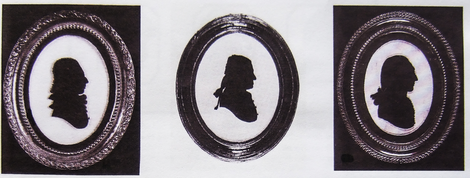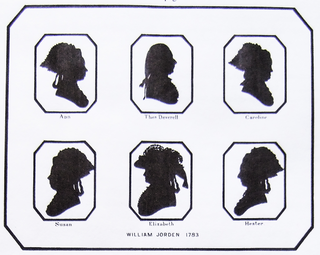Jorden, Richard (SCC Newsletter April 2006)
The Work of the Jorden Brothers on Glass

As a long term collector I was surprised that the silhouette illustrated above had failed to sell at two Bonhams Sales in the last fifteen months (although I have subsequently heard that it sold after the last Sale at a figure below the lower reserve i.e. £500. This silhouette had been sold at the Pollak Sale in February 1995 for more than twice what it sold for this year.i.e. £1,100. I noticed in 1995 that there was a loss of paint in the main body of the silhouette yet the outline and decorative detail were perfect. So sometime between 1996 and 2005 it had been successfully restored. Also it had been re-framed at some earlier point in it's history. This started me thinking about the value of silhouettes generally as well as wondering whether there was some problem for collectors about silhouettes on glass. These thoughts provided the stimulus for this article on two major artists, who painted in this medium.
When I started collecting silhouettes in about 1964 I had no hope of possessing a silhouette by Walter or Richard Jorden -gentleman or lady. A decorative lady by Walter Jorden was considered to be a real 'prize' for a collector and commanded a high price. For example at Mrs.McKechnie's Sale in July, 1979 two hatted ladies with feathers and ribbons by Walter were sold for £750 and £680 respectively on the hammer. At the time the higher price was reported in the Daily Telegraph as being a record for a silhouette on glass at that time.
Sometimes in these early days I would be lucky to get cheaply a work by John Miers or Mrs Beetham at my local auction house - as the auction house knew nothing about silhouettes at that time! (Mrs.McKechnie's Book had not been published) Unfortunately I had a Brighton 'rival', who had considerably more funds available than myself -so my luck was sporadic! Therefore, I had to rely on keeping my eye on the shops, wherever I happened to be - always hoping that I would spot an unrecognised 'treasure' before another avid collector! I was successful on occasions. Oh! for the old days I sigh, but I know these will not return. The Antique Roadshow, Bargain Hunt, Flog-It, Cash-in-the-Attic and all the information on the web have changed all this - enough reminiscing and nostalgia!.
Jorden Page 2
Background of the Artists
Virtually nothing is known about the brothers' lives outside their painting of silhouettes. Dates of birth and death are unrecorded. Walter is thought to be the elder brother, as he started producing silhouettes at an earlier date than Richard. Whether either married or had a family is not known - or where they lived. However, it is known that they worked in Wales, Dorset, London and Durham and probably travelled to several other places in the British Isles. Lady Shaftesbury became their patron and some of their 'sitters' were from titled and influential people of the day - so presumably their work was highly regarded by the people that mattered. It is known whether they had royal 'connections' in the same way as Rosenberg and Hamlet the Elder. They did not print a trade label or advertise in the local newspapers of the towns they visited- however a few works have inscriptions on the reverses and this enabled Mrs.McKechnie to date the period of their silhouettes careers - Walter 1776 to 1786 and Richard 1779 to 1785. There is some 'evidence' that Walter may have had other artistic skills - possibly producing paintings and drawings. It is unlikely that Richard had these talents and it is suggested that he may have come into silhouettes as a result of his brother's influence and success in the years 1776-79.
Arthur Mayne in an article in the Antique Collector of October 1969 made some useful comments distinguishing the work of the two brothers. He considered Richard to be somewhat stern in style and to be a man's profilist - stating "Richard was the Roundhead". Whereas he considered Walter had a lighter touch and excelled with his ladies - stating "Walter was the Cavalier". Now to look at the work of the brothers individually.
Richard Jorden fl. 1779 - 1785
(main reference see Mrs McKechnie pages 548-549)
His work. Little has been written about his work. Unlike his brother he also cut-out silhouettes - I looked at this aspect of his work in a short article in the November 1994 Newsletter. Works have been attributed to him as a result of two signed and inscribed examples. The signatures were considered to be in a contemporary hand and one was dated 1782.
His style. He painted on flat glass in a style that has been described as “pretty plain” and economical in it’s detail. He did not use a needle or a quill and painted in a dense black. However, his style developed somewhat over the years - viz - he made a modification in his bust-line terminations and attempted more detail to show shirt-fronts and buffon detail.
His gentlemen. There are more extant examples of men by this artist that there are of women. He painted their coat buttons very small and there is no transparency on shirt frills - these being shown by a scalloped line.

Above are illustrated three examples of his work showing a somewhat ‘flat’ bust-line termination. It is difficult to see the shirt-frill detail of the cockade hatted gent, but there is some smudged pigment in the space between the scalloped outline. He is illustrated in the Book no. 1118 p. 593. The man on the right has an inscription on the reverse “Richd. Jorden fecit 1782”. He is illustrated in the Book no. 1114 p. 592. The middle gent is a cleric.
Jorden page 3
As time went on his bust-line termination had a more convex/concave shape - it also became more rounded at the front as I will show with the next three examples illustrated below. Strangely two of these have a red line surrounding the silhouette - whether this was done by the artist or by 'owners' it is difficult to know as several with this red line have appeared in the sale-rooms. The gent on the left is Capt. T Lipeyart - he was sold at Bonhams in October 2000 as being by Walter, but I am certain that he is not. Interestingly he did not sell est. 300- 500. The gent in the centre was sold at Sotheby's in December 1980, when he made £70- note the small buttons on his jacket. The gent on the right appeared at Bonhams in September 2004. Both he and the gent on the left have the red painted inset.

His Women
Like the men these were also short on detail, but their outlines were very effective and sharp showing head-dresses and hats, feathers and frills to good advantage. He gradually improved on this outline as time went on, perhaps influenced by his brother! The three examples I have illustrated below three ladies that I hope show his good points. The young girl on the left is a member of the Talbot family and she has a red painted inset. She was sold at Christie's in November 1995 and she made £400. The lady in the centre is illustrated in the Book no. 1117 p. 593. On her reverse is an inscription - also illustrated In the Book no. 1120 and it was taken as Brecon. The lady on the right is said to be Elizabeth Pitt the wife of William Pitt. She was sold at the Ransford Sale in November 1999 at Bonhams - she made £450. She was catalogued as being by Walter, but i think she is by Richard. She is surrounded by a red inset.

Jorden Page 4

Above are six members of the Deverell Family, which i think show Richard’s work at it’s best. The banging chignon hair style was perfect for him as well as his brother with his more decorative approach. This group is illustrated in the Book no. 1115 p. 592. As you will see it was attributed to William Jorden by Mrs. Jackson but later it was established that his name was in fact Walter. Mrs. McKechnie took the view that this Family was by Richard and not Walter.

Jorden Page 5
The two photographs on the previous page are of a lady and gent bought by a collector at Sotheby's in June 1979. There were two further couples by Richard at the same sale, but unfortunately the catalogue photos were not good enough to reproduce. The two other ladies were more showy than mine and better looking!
His Frames.
He used oval pressed brass frames or oval gilt-wood backing these with a second piece of glass with gesso - giving the silhouette a greenish effect. The second piece of glass has frequently been removed over the years perhaps to avoid the greenish appearance. The ovals of the frames varied from 3.5 +” by 2.5 +”
Full-length work.
Jack Pollak and Arthur Mayne became very excited by the 'discovery’ of a conversation piece in the late 1960s - which they attributed on stylistic grounds to Richard Jorden. It is of George III and Queen Charlotte with a small dog. It is entitled "Royalty at Play" It is somewhat simplistically painted but quite effective nevertheless. It is 9.5" by 11.5”. The movement of the dog is well conveyed, but strangely it is painted on slightly convex glass, which is unusual. Jack Pollak acquired this silhouette and presented it to the Queen - so it is now part of the Royal Collection. No other full-length works by Richard are recorded.








